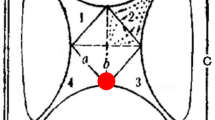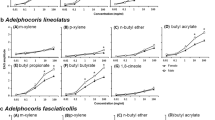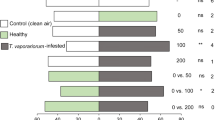Abstract
The African citrus triozid, Trioza erytreae Del Guercio (Hemiptera: Triozidae) is one of the primary vectors of the bacterium Candidatus Liberibacter spp. which causes citrus greening, a disease of global economic importance in citrus production. Despite its economic importance, little is known about its chemical ecology. Here, we used behavioral assays and chemical analysis to study the chemical basis of interaction between T. erytreae and one of its preferred host plants, Citrus jambhiri. In dual choice Y-tube olfactometer assays, lemon leaf odors attracted females but not males compared to plain air or solvent controls. However, in a petri dish arena assay, both sexes were arrested by lemon leaf odors. Coupled gas chromatography-mass spectrometry (GC/MS) analysis revealed quantitative differences in the odors of flushing and mature leaves, dominated by terpenes. Twenty-six terpenes were identified and quantified. In Petri dish arena assays, synthetic blends of the most abundant terpenes mimicking lemon flushing leaf odors elicited varying behavioral responses from both sexes of T. erytreae. A nine-component blend and a blend of the three most abundant terpenes; limonene, sabinene and β-ocimene arrested both sexes of T. erytreae. In contrast, a six-component blend lacking in these three components elicited an avoidance response in both sexes. Furthermore, both sexes of T. erytreae preferred the three-component synthetic blend to lemon crude volatile extract. These results suggest that lemon terpenes might be used in the management of T. erytreae.







Similar content being viewed by others
References
Aidoo OF, Tanga CM, Paris TM, Allan SA, Mohamed SA, Khamis FM, Sétamou M, Borgemeister C, Ekesi S (2018) Size and shape analysis of Trioza erytreae Del Guercio (Hemiptera: Triozidae), vector of citrus huanglongbing disease. Pest Manag Sci 75:760–771
Aitchison J (1986) The statistical analysis of compositional data. Monographs on statistics and applied probability. Chapman and Hall, London
Alves G, Diniz A, Parra J (2014) Biology of the huanglongbing vector Diaphorina citri (Hemiptera: Liviidae) on different host plants. J Econ Entomol 107:691–696
Annecke DP, Cilliers CJ (1963) The citrus psylla, Trioza erytreae (Del Guercio), and its parasites in South Africa. S Afr J Agric Sci 6:187–192
Aubert B (1987) Trioza erytreae Del Guercio and Diaphorina citri Kuwayama (Homoptera: Psylloidea), the two vectors of citrus greening disease: biological aspects and possible control strategies. Fruits 42:149–162
Aubert B, Garnier M, Cassin J, Bertin Y (1988) Citrus greening disease survey in east and west African countries south of Sahara. In: International Organization of Citrus Virologists Conference Proceedings 10, pp 226–230
Azam M, Jiang Q, Zhang B, Xu C, Chen K (2013) Citrus leaf volatiles as affected by developmental stage and genetic type. Int J Mol Sci 14:17744–17766
Babushok VI, Linstrom PJ, Zenkevich IG (2011) Retention indices for frequently reported compounds of plant essential oils. J Phys Chem Ref Data 40:043101
Begemann GJ (1984) The establishment of a citrus psylla colony, Trioza erytreae (Psylloidea: Triozidae), at Zabediela. Proceedings greening symposium. Citrus and Subtropical Fruit Research Institute (CSFRI) Publication, Nelspruit, pp 115–119
Belasque J Jr, Bassanezi RB, Yamamoto PT, Ayres AJ, Tachibana A, Violante AR, Tank A Jr, Di Giorgi F, Tersi FEA, Menezes GM, Dragone J (2010) Lessons from huanglongbing management in São Paulo state, Brazil. J Plant Pathol 92:285–302
Bruce TJ, Cork A (2001) Electrophysiological and behavioral responses of female Helicoverpa armigera to compounds identified in flowers of African marigold, Tagetes erecta. J Chem Ecol 27:1119–1131
Bruce TJ, Pickett JA (2011) Perception of plant volatile blends by herbivorous insects–finding the right mix. Phytochemistry 72:1605–1611
Burckhardt D, Ouvrard D (2012) A revised classification of the jumping plant-lice (Hemiptera: Psylloidea). Zootaxa 3509:1–34
Burger H, Dötterl S, Ayasse M (2010) Host-plant finding and recognition by visual and olfactory floral cues in an oligolectic bee. Funct Ecol 24:1234–1240
Catling HD (1969) The bionomics of the south African citrus psylla, Trioza erytreae (Del Guercio)(Homoptera: Psyllidae) I. The influence of the flushing rhythm of citrus and factors which regulate flushing. J Entomol Soc S Afr 32:191–208
Catling HD (1970) Distribution of the psyllid vectors of citrus greening disease, with notes on the biology and bionomics of Diaphorina citri. FAO Plant Prot Bull 18:8–15
Catling HD (1973) Notes on the biology of the south African citrus psylla, Trioza erytreae (Del Guercio)(Homoptera: Psyllidae). J Entomol Soc S Afr 36:299–306
Cocuzza GEM, Alberto U, Hernández-Suárez E, Siverio F, Di Silvestro S, Tena A, Carmelo R (2017) A review on Trioza erytreae (African citrus psyllid), now in mainland Europe, and its potential risk as vector of huanglongbing (HLB) in citrus. J Pest Sci 90:1–17
Cook G, Maqutu V, Van Vuuren S (2014) Population dynamics and seasonal fluctuation in the percentage infection of Trioza erytreae with 'Candidatus' Liberibacter africanus, the African citrus greening pathogen, in an orchard severely infected with African greening and transmission by field-collected Trioza erytreae. Afr Entomol 22:127–135
Dudareva N, Martin D, Kish CM, Kolosova N, Gorenstein N, Fäldt J, Miller B, Bohlmann J (2003) (E)-β-Ocimene and myrcene synthase genes of floral scent biosynthesis in snapdragon: function and expression of three terpene synthase genes of a new terpene synthase subfamily. Plant Cell 15:1227–1241
Ekesi S (2012) Arthropod pest composition and farmers perceptions of pest and disease problems on citrus in Kenya. Book of Abstract. In: XII International Citrus Congress, Valencia, Spain, November, 2012, pp 283
Figueiredo AC, Barroso JG, Pedro LG, Scheffer JJ (2008) Factors affecting secondary metabolite production in plants: volatile components and essential oils. Flavour Fragr J 23:213–226
Friedman L, Miller JG (1971) Odor incongruity and chirality. Science 172:1044–1046
Geiger F, Bengtsson J, Berendse F, Weisser WW, Emmerson M, Morales MB, Ceryngier P, Liira J, Tscharntke T, Winqvist C, Eggers S (2010) Persistent negative effects of pesticides on biodiversity and biological control potential on European farmland. Basic Appl Ecol 11:97–105
Gkinis G, Tzakou O, Iliopoulou D, Roussis V (2003) Chemical composition and biological activity of Nepeta parnassica oils and isolated nepetalactones. Zeitschrift für Naturforschung C 58:681–686
Green G, Catling H (1971) Weather-induced mortality of the citrus psylla, Trioza erytreae (Del Guercio)(Homoptera: Psyllidae), a vector of greening virus, in some citrus producing areas of southern Africa. Agric Meteorol 8:305–317
Grissa-Lebda K, Sahraoui H (2017) Pest control in organic citrus groove. In: Vacante V, Kreiter S (eds) Handbook of pest management in organic farming. CABI, Boston, pp 78–129
Gross J, Mekonen N (2005) Plant odours influence the host finding behaviour of apple psyllids (Cacopsylla picta; C. melanoneura). IOBC/WPRS Bull 28:351
Kartal N, Sokmen M, Tepe B, Daferera D, Polissiou M, Sokmen A (2007) Investigation of the antioxidant properties of Ferula orientalis L. using a suitable extraction procedure. Food Chem 100:584–589
Khater HF (2012) Prospects of botanical biopesticides in insect pest management. Pharmacologia 3:641–656
Kilalo D, Olubayo F, Obukosia S, Shibairo SI (2009) Farmer management practices of citrus insect pests in Kenya. Afr J Hortic Sci 2:168–176
Kleiber JR, Unelius CR, Lee JC, Suckling DM, Qian MC, Bruck DJ (2014) Attractiveness of fermentation and related products to spotted wing Drosophila (Diptera: Drosophilidae). Environ Entomol 43:439–447
Kristoffersen L, Hallberg E, Wallén R, Anderbrant O (2006) Sparse sensillar array on Trioza apicalis (Homoptera, Triozidae) antennae—an adaptation to high stimulus levels? Arthropod Struct Dev 35:85–92
Landolt PJ, Phillips TW (1997) Host plant influences on sex pheromone behavior of phytophagous insects. Annu Rev Entomol 42:371–391
Lapis E, Borden J (1993) Olfactory discrimination by Heteropsylla cubana (Homoptera: Psyllidae) between susceptible and resistant species of Leucaena (Leguminosae). J Chem Ecol 19:83–90
Lewis-Rosenblum H, Martini X, Tiwari S, Stelinski LL (2015) Seasonal movement patterns and long-range dispersal of Asian citrus psyllid in Florida citrus. J Econ Entomol 108:3–10
Mann R, Rouseff R, Smoot J, Castle W, Stelinski L (2011) Sulfur volatiles from Allium spp. affect Asian citrus psyllid, Diaphorina citri Kuwayama (Hemiptera: Psyllidae), response to citrus volatiles. Bull Entomol Res 101:89–97
Mann RS, Rouseff RL, Smoot J, Rao N, Meyer WL, Lapointe S, Robbins PS, Cha D, Linn CE, Webster FX, Tiwari S (2013) Chemical and behavioral analysis of the cuticular hydrocarbons from Asian citrus psyllid, Diaphorina citri. Insect Sci 20:367–378
Matias EF, Alves EF, Silva MK, Carvalho VR, Figueredo FG, Ferreira JV, Coutinho HD, Silva JM, Ribeiro-Filho J, Costa JG (2016) Seasonal variation, chemical composition and biological activity of the essential oil of Cordia verbenacea DC (Boraginaceae) and the sabinene. Ind Crop Prod 87:45–53
Miller JR, Strickler KL (1984) Finding and accepting host plants. In: Bell WJ, Carde RT (eds) Chemical ecology of insects. Springer, Boston, pp 127–157
Mimica-Dukić N, Kujundžić S, Soković M, Couladis M (2003) Essential oil composition and antifungal activity of Foeniculum vulgare mill. Obtained by different distillation conditions. Phytotherapy Research: An International Journal Devoted to Pharmacological and Toxicological Evaluation of Natural Product Derivatives 17:368–371
Moran V, Brown R (1973) The antennae, host plant chemoreception and probing activity of the citrus psylla, Trioza erytreae (Del Guercio)(Homoptera: Psyllidae). J Entomol Soc S Afr 36:191–202
Moran V, Buchan P (1975) Oviposition by the citrus psylla, Trioza erytreae (Homoptera: Psyllidae), in relation to leaf hardness. Entomol Exp Appl 18:96–104
Nguyen LA, He H, Pham-Huy C (2006) Chiral drugs: an overview. Int J Biomed Sci 2:85
Njuguna PK, Murungi LK, Fombong A, Teal PE, Beck JJ, Torto B (2018) Cucumber and tomato volatiles: influence on attraction in the melon fly Zeugodacus cucurbitate (Diptera: Tephritidae). J Agric Food Chem 66:8504–8513
Noldus LP, Spink AJ, Tegelenbosch RA (2002) Computerised video tracking, movement analysis and behaviour recognition in insects. Comput Electron Agric 35:201–227
Patt J, Setamou M (2010) Responses of the Asian citrus psyllid to volatiles emitted by the flushing shoots of its rutaceous host plants. Environ Entomol 39:618–624
Patt JM, Stockton D, Meikle WG, Sétamou M, Mafra-Neto A, Adamczyk JJ (2014) Innate and conditioned responses to chemosensory and visual cues in Asian citrus psyllid, Diaphorina citri (Hemiptera: Liviidae), vector of Huanglongbing pathogens. Insects 5:921–941
Pavlović M, Kovačević N, Tzakou O, Couladis M (2006) Essential oil composition of Anthemis triumfetti (L.) DC. Flavour Fragr J 21:297–299
Pino JA, Ortega A, Rosado A (1999) Volatile constituents of guava (Psidium guajava L.) fruits from Cuba. J Essent Oil Res 11:623–628
R Development Core Team (2015) R Development Core Team (2009–2018) R: a language and environment for statistical computing. R Foundation for Statistical Computing, Vienna
Reddy GV, Guerrero A (2004) Interactions of insect pheromones and plant semiochemicals. Trends Plant Sci 9:253–261
Renwick J, Radke CD (1987) Chemical stimulants and deterrents regulating acceptance or rejection of crucifers by cabbage butterflies. J Chem Ecol 13:1771–1776
Robbins PS, Alessandro RT, Stelinski LL, Lapointe SL (2012) Volatile profiles of young leaves of Rutaceae spp. varying in susceptibility to the Asian citrus psyllid (Hemiptera: Psyllidae). Fla Entomol 95:774–776
Samways M (1990) Biogeography and monitoring outbreaks of the African citrus psylla, Trioza erytreae (Del Guercio). In: Aubert B, Tontyaporn S, Buangsuwon D (eds) Proceedings 4th international Asia Pacific conference on Citrus rehabilitation. Chiang Mai, Thailand, pp 188–197
Singh K, Shakya P, Kumar A, Alok S, Kamal M, Singh SP (2014) Stereochemistry and its role in drug design. Int J Pharm Sci Res 5:4644–4659
Soroker V, Talebaev S, Harari AR, Wesley SD (2004) The role of chemical cues in host and mate location in the pear psylla Cacopsylla bidens (Homoptera: Psyllidae). J Insect Behav 17:613–626
Stensmyr MC, Giordano E, Balloi A, Angioy A-M, Hansson BS (2003) Novel natural ligands for Drosophila olfactory receptor neurones. J Exp Biol 206:715–724
Tamesse JL, Messi J (2004) Facteurs influenc¸ant la dinamique des populations du psylle africain des agrumes Trioza erytreae Del Guercio (Hemiptera: Triozidae) au Cameroun. Int J Trop Insect Sci 24:213–227
Tamiru A, Bruce TJ, Woodcock CM, Caulfield JC, Midega CA, Ogol CK, Mayon P, Birkett MA, Pickett JA, Khan ZR (2011) Maize landraces recruit egg and larval parasitoids in response to egg deposition by a herbivore. Ecol Lett 14:1075–1083
Tiwari S, Mann RS, Rogers ME, Stelinski LL (2011) Insecticide resistance in field populations of Asian citrus psyllid in Florida. Pest Manag Sci 67:1258–1268
van den Berg M (1990) The citrus pyslla, Trioza erytreae (Del Guercio)(Hemiptera: Triozidae): A review. Agric Ecosyst Environ 30:171–194
van den Berg M, Deacon V (1988) Dispersal of the citrus psylla, Trioza erytreae (Hemiptera: Triozidae), in the absence of its host plants. Phytophylactica 20:361–368
van den Berg M, Deacon VE, Steenekamp P (1991) Dispersal within and between citrus orchards and native hosts, and nymphal mortality of citrus psylla, Trioza erytreae (Hemiptera: Triozidae). Agric Ecosyst Environ 35:297–309
Walter AJ, Hall DG, Duan YP (2012) Low incidence of ‘Candidatus Liberibacter asiaticus’ in Murraya paniculata and associated Diaphorina citri. Plant Dis 96:827–832
Wenninger EJ, Stelinski LL, Hall DG (2009) Roles of olfactory cues, visual cues, and mating status in orientation of Diaphorina citri Kuwayama (Hemiptera: Psyllidae) to four different host plants. Environ Entomol 38:225–234
Yamasaki Y, Kunoh H, Yamamoto H, Akimitsu K (2007) Biological roles of monoterpene volatiles derived from rough lemon (Citrus jambhiri lush) in citrus defense. J Gen Plant Pathol 73:168–179
Acknowledgements
The authors are grateful to Ms. Lydia Mukomuga Kailanya and citrus farmers in Mikinduri district, Meru County, Kenya for their assistance in the field collection of the triozids for insectary rearing. We also thank Dr. Daisy Salifu for guidance in data analysis. We gratefully acknowledge the financial support for this research by the following organisations and agencies: BMZ/ GIZ through the project on “Strengthening Citrus Production Systems through the Introduction of Integrated Pest Management (IPM) Measures for Pests and Diseases in Kenya and Tanzania (SCIPM)” (Project no.: 14.1432.5-001.00/Contract no.: SCIPM 81180346) through the International Centre of Insect Physiology and Ecology (icipe); UK Aid from the UK Government; Swedish International Development Cooperation Agency (Sida); the Swiss Agency for Development and Cooperation (SDC); and the Kenyan Government. AKAA was supported by a German Academic Exchange Service (DAAD) In-Region Postgraduate Scholarship. The views expressed herein do not necessarily reflect the official opinion of the donors.
Author information
Authors and Affiliations
Corresponding author
Electronic supplementary material
ESM 1
(DOCX 1967 kb)
Rights and permissions
About this article
Cite this article
Antwi-Agyakwa, A.K., Fombong, A.T., Deletre, E. et al. Lemon Terpenes Influence Behavior of the African Citrus Triozid Trioza erytreae (Hemiptera: Triozidae). J Chem Ecol 45, 934–945 (2019). https://doi.org/10.1007/s10886-019-01123-y
Received:
Revised:
Accepted:
Published:
Issue Date:
DOI: https://doi.org/10.1007/s10886-019-01123-y




